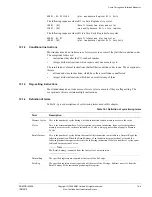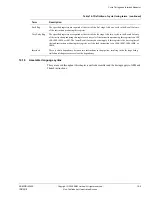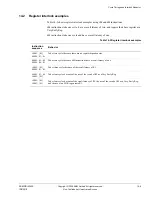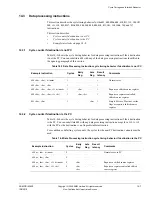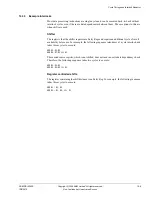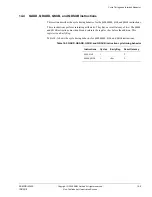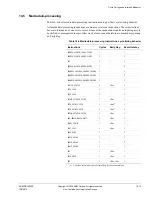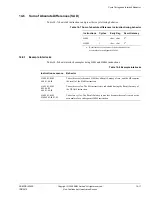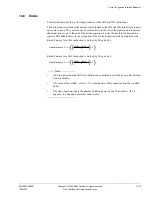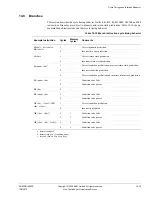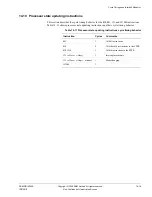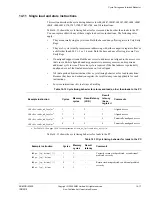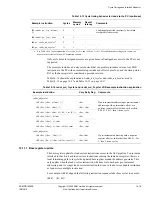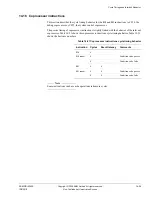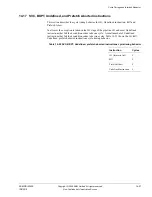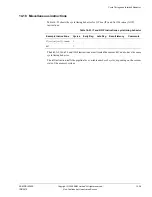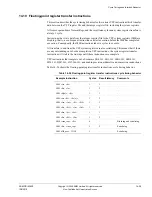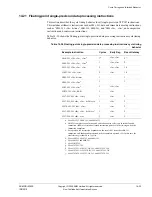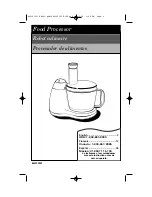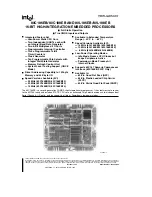
Cycle Timings and Interlock Behavior
ARM DDI 0363E
Copyright © 2009 ARM Limited. All rights reserved.
14-17
ID013010
Non-Confidential, Unrestricted Access
14.11 Single load and store instructions
This section describes the cycle timing behavior for
LDR
,
LDRHT
,
LDRSBT
,
LDRSHT
,
LDRT
,
LDRB
,
LDRBT
,
LDRSB
,
LDRH
,
LDRSH
,
STR
,
STRT
,
STRB
,
STRBT
,
STRH
, and
PLD
instructions.
Table 14-12 shows the cycle timing behavior for stores and loads, other than loads to the PC.
You can replace
LDR
with any of these single load or store instructions. The following rules
apply:
•
They are normally single-cycle issue. Both the base and any offset register are Very Early
Regs.
•
They are 3-cycle issue if pre-increment addressing with either a negative register offset or
a shift other than LSL #1, 2 or 3 is used. Both the base and any offset register are Very
Early Regs.
•
If unaligned support is enabled then accesses to addresses not aligned to the access size
that cross a 64-bit aligned boundary generate two memory accesses, and require an
additional cycle to issue. This extra cycle is required if the final address is potentially
unaligned, even if the final address turns out to be aligned.
•
PLD
(data preload hint instructions) have cycle timing behavior as for load instructions.
Because they have no destination register, the result latency is not-applicable for such
instructions.
•
For store instructions
<Rt>
is always a Late Reg.
Table 14-13 shows the cycle timing behavior for loads to the PC.
Table 14-12 Cycle timing behavior for stores and loads, other than loads to the PC
Example instruction
Cycles
Memory
cycles
Result latency
(LDR)
Result
latency
(base
register)
Comments
LDR <Rt>, <addr_md_1cycle>
a
1
1
2
1
Aligned access
LDR <Rt>, <addr_md_3cycle>
a
3
1
4
3
Aligned access
LDR <Rt>, <addr_md_1cycle>
a
2
2
3
2
Potentially unaligned access
LDR <Rt>, <addr_md_3cycle>
a
4
2
5
4
Potentially unaligned access
a. See Table 14-14 on page 14-18 for an explanation of
<addr_md_1cycle>
and
<addr_md_3cycle>
.
Table 14-13 Cycle timing behavior for loads to the PC
Example instruction
Cycles
Memory
cycles
Result
latency
Comments
LDR pc, [sp, #<imm>] (!)
1
1
-
Correctly return stack predicted, or conditional
predicted correctly
LDR pc, [sp], #<imm>
1
1
-
LDR pc, [sp, #<imm>] (!)
9
1
-
Return stack mispredicted, conditional predicted
correctly
LDR pc, [sp], #<imm>
9
1
-


